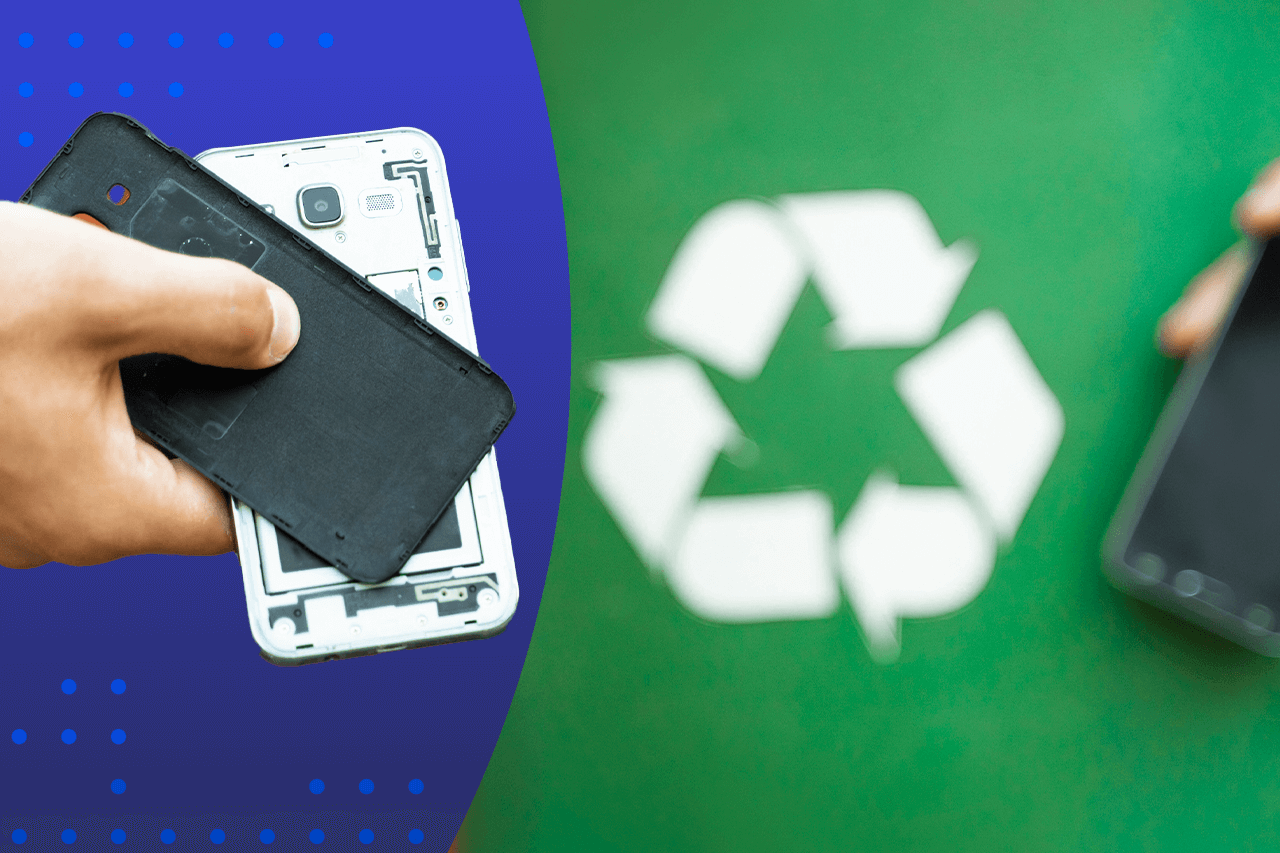
Do You Know the Benefits of Electronics Recycling?
April 29, 2021 - Ellie Gabel
Revolutionized is reader-supported. When you buy through links on our site, we may earn an affiliate commision. Learn more here.
Many people in today’s society feel compelled to buy the newest electronics. However, if old models aren’t traded in, they may end up as electronic waste (e-waste). Electronics recycling is an alternative to that possibility. Why is electronics recycling important?
Electronics Recycling Promotes Environmental Sustainability and Human Health
Research shows that improperly discarded electronics cause complications that harm the environment and people who live near landfills. For example, toxic chemicals can leach into the soil, water sources and air, damaging aquatic and plant life. Similarly, the toxins associated with e-waste can negatively affect the health of people who live and work near landfills.
There’s a long way to go to make progress because only 17.4% of e-waste was collected and recycled in 2019. It’s also not enough for someone to commit to recycling their electronics. That’s a good start, but there’s a problem with informal recycling practices. The workers who process the goods may not have adequate protective gear. They may also lack the training that teaches them how to recycle responsibly and prevent harm to people and the environment.
The average person’s activities cause 4.6 pounds of new trash per day. When that rubbish doesn’t end up in landfills, it gets into oceans and other environmental habitats. The ramifications of incorrect electronics disposal emphasize why it’s important for people to avoid the temptation of tossing an unwanted smartphone into the nearest garbage bin.
Committing to having electronics responsibly recycled allows people to take proactive steps toward protecting the Earth. One way to do that is to confirm what happens to electronics deemed unsuitable for recycling. As of 2019, 78 countries had e-waste regulations, up from 61 in 2014. One common tactic is for developed countries to send electronics waste to nations that don’t have such laws. That trend poses risks to the environment and human health.
Recycled Electronics Can Offer People New Opportunities
There’s an ongoing push to make it as straightforward as possible for consumers to recycle their unwanted electronics. Some retailers have collection points near their entrances so people can drive up and deposit items or put them in the receptacles during planned shopping trips. The goal is to convince people that they can do good by bringing electronics they no longer want so they or their materials can be repurposed.
That’s certainly one benefit, but electronics recycling can give people additional chances to thrive, too. One Los Angeles initiative focuses on assisting formerly incarcerated individuals who often find it difficult to get jobs after serving their time. The program reportedly processes 30,000 to 40,000 pounds of electronics per week. The workers attempt to refurbish the items, including the more than 5,000 computers acquired in 2020. When that’s not possible, products in poor condition or that are older, such as floppy disk drives, are sold as scrap metal.
Elsewhere, an initiative from Colorado’s National Coalition Against Domestic Violence (NCADV) urges people to donate smartphones, MP3 players, laptops and other electronics to a partnership between the organization and an electronics recycler. NCADV receives a portion of the funds generated from the sale of refurbished items. In 2018 alone, this electronics recycling program brought more than $23,000 to NCADV.
The organization uses that money to directly support people affected by domestic violence and their allies. Thus, when someone donates electronics that way, they could help a violence survivor work toward a safer, more secure life.
E-Waste May Become Creative, Classy Furniture
E-waste reduction initiatives often center on getting unwanted electronics into functional condition or extracting the precious metals from them to create new gadgets. However, an Amsterdam-based research project called Studio Formafantasma focuses on using e-waste to make furniture.
Several years ago, Australia’s National Gallery of Victoria commissioned the couple behind the business to design pieces for its collection. Mining is an important facet of Australia’s economy, and the pair initially looked for ways to use mined materials in their work. However, while investigating that strategy, they became more interested in materials from the growing amount of the world’s e-waste.
After significant research into so-called above-ground mining of metals, they came up with a furniture collection that integrated their findings. For example, there’s a tabletop supported by a stack of iPhones. Gold from circuit boards becomes leaf or plating on some pieces. There’s even a glass storage cabinet featuring several computer casings inside it.
The designers admitted they can’t always trace the metals they use to specific consumer products. That’s because it often reaches them as the materials themselves rather than being still part of a gadget.
Lexus, Max Mara and Samsung are some of the studio’s clients. The work spans beyond electronics recycling and explores the societal forces affecting today’s design work. There’s no program for people to send in the electronics they don’t want for inclusion into future furnishings. However, this example should give people concerned about e-waste hope about what’s possible.
Prioritizing Electronics Recycling Helps at-Risk Animal Populations
Even when people know the environmental impacts associated with discarded electronics, they may not understand the ramifications deeply enough. One example came to light in a 2018 study. Researchers linked people’s reluctance to recycle their unwanted phones to the destruction of gorilla habitats in the Democratic Republic of Congo.
The work centered on Grauer gorillas, which live in habitats that are mined for components that end up in mobile phones, such as coltan and gold. The team concluded that if more of those materials came from recycled phones, people engaged in extracting them would become less incentivized to mine them where gorillas live.
Someone involved with the study clarified that 30-40 recycled phones could result in 1 gram of gold. She said that’s exceptionally important since some natural sources of gold may run out by 2030.
The research about the Grauer gorillas happened in conjunction with an area zoo that encouraged visitors to recycle their smartphones and educated them on why it mattered. Other zoological parks have done the same. Wisconsin’s Racine Zoo’s electronics recycling partner accepts old and broken phones, as well as locked devices.
These examples show that electronics recycling is an excellent way to support wildlife preservation. Many people would rather ignore the impacts of the devices they love to own and use. However, the examples here show it’s not difficult to make a positive difference in wildlife welfare by simply recycling smartphones.
Electronics Recycling Supports the Circular Economy
Manufacturers traditionally used the take-make-waste process for production. That concept depleted resources by making products designed for short-term use. Now, companies and consumers are more interested in the circular economy. It involves creating durable products that people can use for longer, restoring natural resources, minimizing pollution, sharing equipment and more.
A recent research achievement also showed that electronics recycling could become a major part of the circular economy soon. Scientists developed an innovative method of using a fruit peel to pull precious metals from lithium-ion batteries. They’re some of the most common power sources for consumer electronics, including phones, laptops and tablets.
This novel approach tackles both e-waste and food waste, which are well-documented and worsening problems. Also, this strategy supports the circular economy principle of keeping resources in use for as long as possible.
The current way of dealing with nonfunctional batteries is to expose them to extreme heat to smelt the in-demand metals. However, that approach releases poisonous gases. Some alternative methods still release secondary pollutants and risk worker health, making researchers eager to find safer options.
This team showed that an orange peel offered the necessary effectiveness for letting them remove precious metals from depleted batteries and use them to make new power sources.
Electronics Recycling Brings Multiple Advantages
When people decide to recycle their electronics through reputable means, they can directly impact the environment, human health, wildlife habitats, and more. If manufacturers and electronics retailers continue making it convenient for people to drop off their electronics for recycling, there should be an ongoing uptick in participation.
Revolutionized is reader-supported. When you buy through links on our site, we may earn an affiliate commision. Learn more here.
Author
Ellie Gabel
Ellie Gabel is a science writer specializing in astronomy and environmental science and is the Associate Editor of Revolutionized. Ellie's love of science stems from reading Richard Dawkins books and her favorite science magazines as a child, where she fell in love with the experiments included in each edition.




